Icy Inverts Cruise 2013 - Shipboard Blog - Jan 2nd to Jan 5th
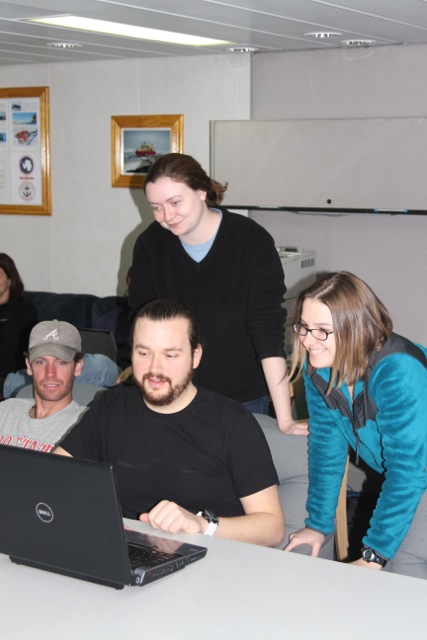
05 Jan 2013: Outside the Drake Passage (58° 54.2’S, 80° 48.6’W)
We have made it through the infamous Drake Passage without major problems. The seas reached as high as 6 meters (18 feet), but that’s considered better than average. Luckily for those prone to seasickness, but perhaps unluckily for the thrill-seekers among us, our crossing has been quite smooth.
During these quiet transit days, all of us onboard have been getting to know each other and discussing our research goals for the expedition. As for me, I’m a Ph.D. student in Chief Scientist Ken Halanych’s laboratory at Auburn University. This is my second major research expedition, and my third research cruise. My first major expedition was 5 weeks around Iceland, where fellow graduate student Kevin Kocot and I (above picture center) joined a German group researching Iceland’s deep-sea invertebrates. Although I’ve been on a long expedition before, much of what we’ll encounter is brand new, and every ship is different. A pleasant surprise here on the NBP is that we all have a daily quota of internet fast enough to allow Google Chat conversations with family and friends back home. A real-time conversation goes a long way towards making one feel less isolated. Mostly, I’m just thrilled to soon be one of the lucky few who can say they have crossed both the Arctic and the Antarctic polar circles!
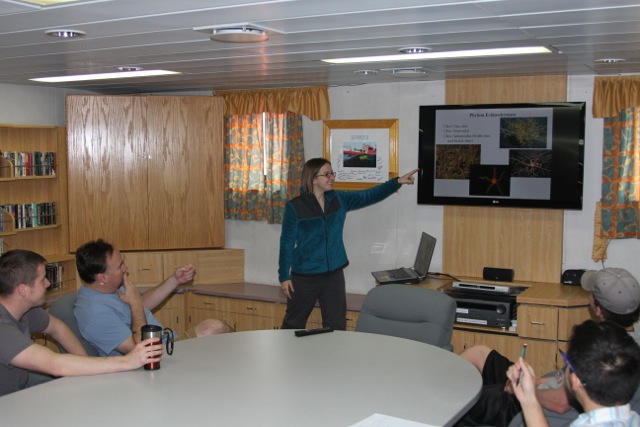
Every day since we set sail, we have had presentations from the scientists on board (like in above picture) so that we are all well prepared for the first dredge. These short talks have included pictures of favorite study species, or descriptions of ongoing projects that will be continuing during this expedition. We have scientists with us from 8 different universities from the US and Europe, so this has been a great way to learn about, and from, our shipmates. It’s important that all the scientists understand each other’s goals, so that if someone’s favorite animal comes up in a dredge while that person is asleep (such as seastars like Labidiaster annulatus [below picture]), the rest of the team will know what to do. As much as we all might like to be awake and participating in every dredge, the trawls will operate 24/7, and we will need to rely on each other and good communication to ensure that no important samples are lost or mishandled. Over the next few weeks here on the blog, we’ll describe some of these unique animals and why they are important to study. Stay tuned, the best part of the adventure is coming soon!
Contributed by: Joie Cannon, Ph.D. Candidate, Auburn University
P.S. – After writing this piece, we discovered that we were turning around and returning to Punta Arenas due to a medical issue. Given that we are traveling to one of the most remote regions on the planet, we are extremely far away from medical care. Thus, health and safety are the top priority. After the issue is addressed, we will head south once more. Again, please stay tuned since the blog wil continue throughout this period.
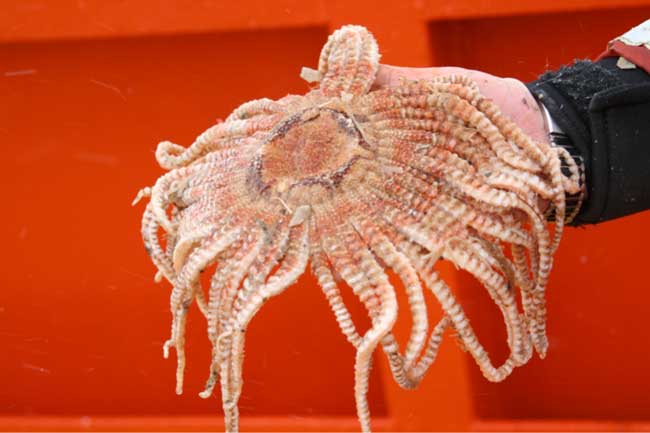
***************************************************************************************
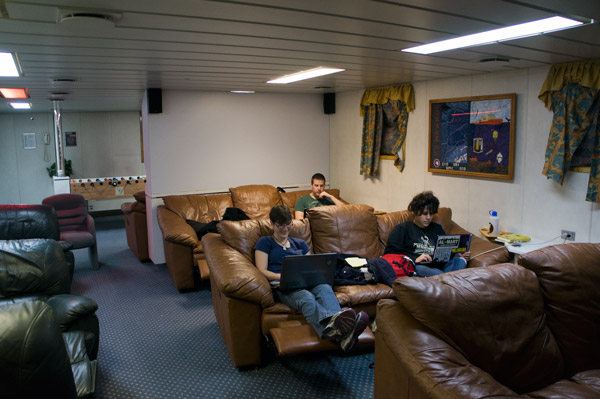
04 Jan 2013: In the Drake Passage (59° 57.1’S, 81° 47.0’W)
Quiet day onboard the R/V Palmer yesterday and it looks like today might be as well. There is kind of a “calm before the storm” feeling to our days right now. Once we make it to the coast of Antarctica, our work begins in earnest and there will be little downtime. For now, everyone has settled in and found their niches on the ship. Quiet places to relax or to catch up on work that might not have gotten finished before the trip started.
For the times when we aren’t working, the Palmer is well stocked with diversions. There is a lounge on the “Oh 2” (02) deck with foosball, darts, comfortable couches (above picture) and a big TV with plenty of movies. We don’t get any sort of TV out here so movies or video games is it. The Palmer also has a ton of books aboard donated by previous travelers. I’ve found several I would love to read but I haven’t started any yet. The ship is still rocking and rolling enough that I think I would get seasick if I tried. When we get closer to Antarctica, the seas may be calmer and those of us who like to read can start. The best and worst diversion is the galley. I know Cheps mentioned the great food and I will concur. It is hard not to overeat. That will be a big challenge for many of us, me included. Fortunately there is a small gym on board (below picture). I like to run and thought I would use the treadmill but when you can’t walk in a straight line down a corridor, jumping on the treadmill doesn't seem like a smart idea. So I will definitely be hitting the rowing machine.
We will be working three shifts during the cruise. It is light 24/7 at this time of year so it’s possible to work around the clock. I will be working with Dr. David Weese (Woody to his friends) on the 1AM - 7AM shift. It’s our responsibility to map potential sampling sites for the next days' sampling using the Multi Beam Sonar system. It gives us a color topographical type image that allows us to make sure we are not sampling over boulders or other obstructions. They can damage our equipment and need to be avoided. Woody and I have already started shifting our sleep times to get ready. I think Saturday night will be our first overnight shift.
Well there’s a ton more to tell but I’ll leave some for the others. Make sure to follow our Twitter feeds and other blogs to get even more info about where we are and what we’re doing.
Much love to my friends and family,
Contributed by: David Branson, Ph.D. Candidate – Marine Molecular Ecology, Auburn University (www.nullpilot.com)
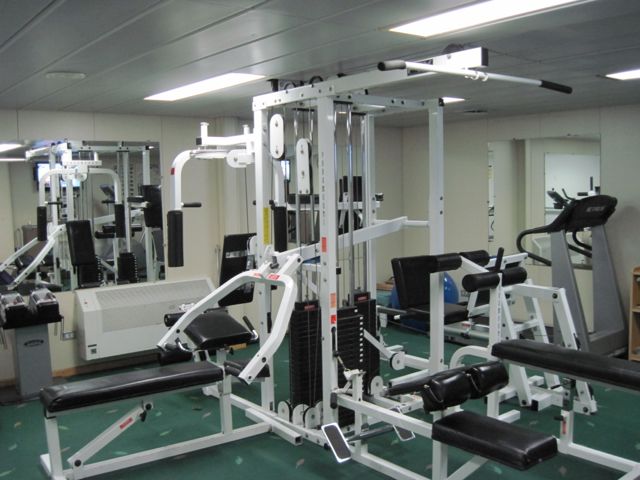
***************************************************************************************
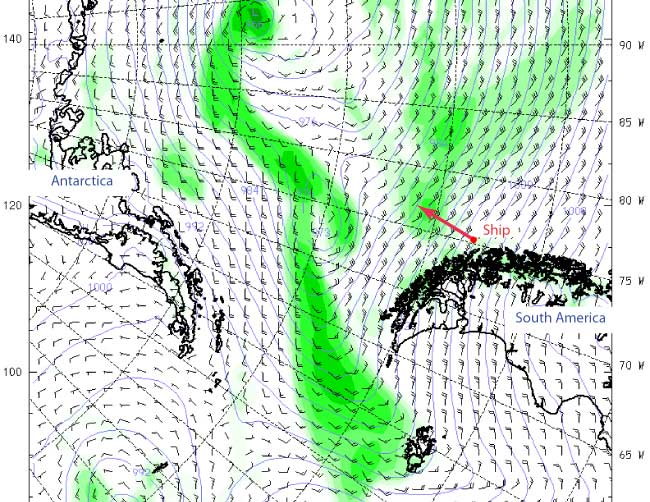
03 Jan 2013: In the Drake Passage (56o 31.5’S, 78o 24.7’W)
Transit – For most of the cruises I have been on, the science work starts after only a few days of transit. This expedition is different! It will take us about 5 days to reach our first sampling station. So how does one utilize their time after leaving the safety of the Straits of Magellan? Well, that all depends on the weather and sea state. On the ship, every one keeps an eye on the weather, but no one really talks about it – sailor’s superstition. The ship’s Captain gets weather feeds from several sources, some more reliable than others, and based on his experience, he tries to make the best speed possible while keeping ship and crew safe. Wind maps such as the one pictured above from 02 January tell most of the story. The little symbols that look like upside down “L”s or the top musical notes are called “barb vectors” with each barb/line coming off the longer line representing 10 knots of wind. As you can see from the map, the forecast was for about 30 knot winds, but last night we had gusts up to 56 knots --- this made waves of approximately 6 meters (18 feet). For many on the ship that meant only one thing….Movie night!!
So far the ride has not been that rough, but several of the science crew are using anti-sea sickness medication that often makes you drowsy. When the ride is smoother, many of us have been working on other scientific projects. It is easy to find a quiet spot on the ship to concentrate and work on manuscripts – no phone or email interruptions!! Alternatively, one can go to the small workout room on the ship….pretty much a must with three meals a day on the ship. One of the fun diversions yesterday occurred when Joe, one of the Internet Technicians, printed out the New York Times crossword on a 3x5 poster and hung it on the wall so that several people could work on the crossword simultaneously (below picture). I have to go see if they finished yet.
Additionally, we are finishing the final stages of preparing for the work ahead. Equipment in the lab need to stay secured until we start working, but we are organizing spreadsheets and notebooks for cataloguing the organisms we will collect. We have also started to look at ice maps. Although we are in an ice capable ship, the ice will still determine where we can and cannot go. You may recall the story of Ernst Shackleton and his ship, the Endurance, which was caught in the ice and crushed. The power of the ice around Antarctic is not to be trifled with.
As for the movie, I missed it, but I am told it was “Ted”, a movie about a teddy bear that is alive. However, this is not a well-behaved bear and I am still explaining to my 10 and 11 year old daughters why they could not go see a movie about a “cute” teddy bear!
Contributed by: Dr. Ken Halanych, Chief Scientist, Schneller Endowed Chair, Auburn University
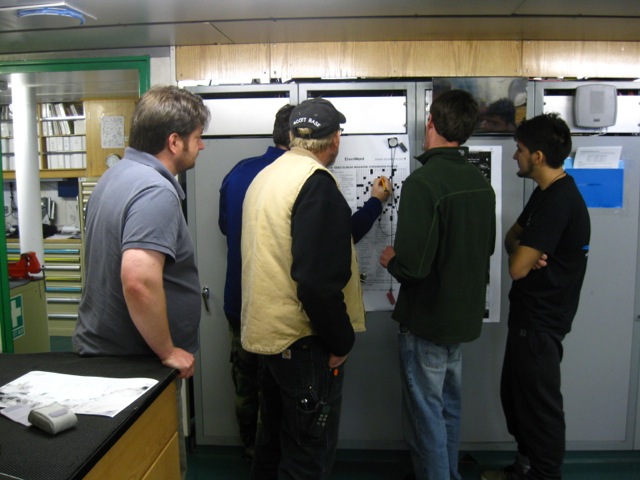
***************************************************************************************
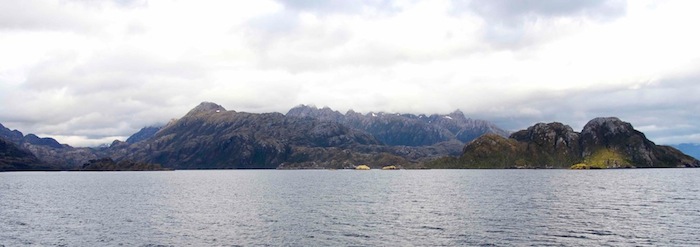
02 Jan 2013: Straights of Magellan (53° 42.6’S, 75° 52.2’W)
I didn't even hear the alarm go off at 0730, however, I woke naturally at 0806, signed in, and wandered down for breakfast (crispy bacon!). I'd like to say I spent the morning working, but a couple of hours extra sleep was needed.
After the R/V Nathaniel B. Palmer casted off from the Punta Arenas pier, we made our way into the Straits of Magellan (above picture). We steamed south for a few hours, watching the civilized world disappear behind us. Lunch (steak and mushrooms) was followed by a safety brief where we were instructed on what to do if various alarms go off.
Mid-afternoon, we turned around the southern most part of mainland South America and started heading northwest. On the southern tip of the continent there was a small mountain adorned with a large cross on the summit. The scenery was becoming more rugged, with glacier scarred hills rising from the sea, while jagged snow-topped mountains rose steeply behind. The Strait became narrower as the afternoon progressed. As we approached the narrowest part of the strait, three separate groups of whales were spotted. The first, 300 meters immediately to port, were two humpbacks. The second two, about 400 meters of the port bow were feeding, I got one glimpse of an enormous mouth erupting from the water. A single photograph of a distant curved fin was enough to tell us these were not humpbacks, but they were too far away for a positive identification. As this was going on, two more unidentified whales were right in front of us, about 500 meters away, moving slowly to port. The display lasted for 15 minutes or so - the first experience of these magical marine monsters for many of our party, but I predict, not the last!
Dinner - wow! Scallops in a tangy coriander and lemongrass sauce (amazing!), grilled lamb cutlets (phenomenal!) sweet chillie zucchini, steamed broccoli and rice. Our cook - Danny - is a master of the craft who obviously loves his job. Right now it is 2200 but still quite light. The scenery is no less dramatic, so, on this note I sign off and go back to enjoy the view.
Contributed by: Dr. Chester "Cheps" Sands (below picture), Molecular Ecologist, British Antarctic Survey, Cambridge, England
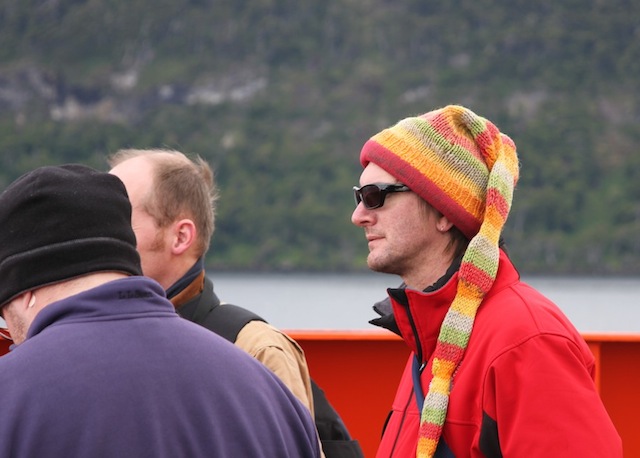
Last updated: 11/12/2013
